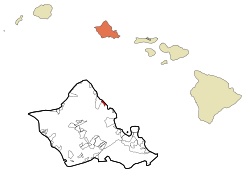Punaluu, Hawaii facts for kids
Quick facts for kids
Punalu'u
|
|
|---|---|

Location in Honolulu County and the state of Hawaii
|
|
| Country | United States |
| State | Hawaii |
| Area | |
| • Total | 2.07 sq mi (5.35 km2) |
| • Land | 1.60 sq mi (4.14 km2) |
| • Water | 0.47 sq mi (1.21 km2) |
| Elevation | 6 ft (2 m) |
| Population
(2020)
|
|
| • Total | 1,374 |
| • Density | 859.82/sq mi (331.95/km2) |
| Time zone | UTC-10 (Hawaii-Aleutian) |
| ZIP code |
96717
|
| Area code(s) | 808 |
| FIPS code | 15-66500 |
| GNIS feature ID | 1853110 |
Punaluʻu is a small, rural community located in Hawaii, United States. It is found on the island of Oʻahu in Honolulu County. The name Punaluʻu comes from the Hawaiian language. It can mean "coral dived for" or possibly "spring dived for," referring to a fishpond that used to be here.
Punaluʻu has a very small shopping area near Punaluʻu Stream. There are also several apartment buildings, including a tall one, at Haleaha Beach and Kaluanui Beach. In 2020, about 1,374 people lived here.
A natural reef stretches out from the coast. Punaluʻu is home to several beautiful beaches and a beach park. These include Punaluʻu Beach Park, Punaluʻu Beach, Haleaha Beach, and Kaluanui Beach. Long ago, sugar cane was grown on the narrow flat land near the coast. The U.S. postal code for Punaluʻu is 96717.
Contents
Exploring Punaluʻu's Location
Punaluʻu is located at 21°35'33" North and 157°53'49" West. This area covers about 5.4 square kilometers (2.1 square miles) in total. Most of this area, about 4.1 square kilometers (1.6 square miles), is land. The rest, about 1.2 square kilometers (0.47 square miles), is water.
The town is situated north of Kahana Bay and Kaʻaʻawa. It is south of Hauʻula along Kamehameha Highway (State Rte. 83). You can find Kaluanui Stream and Sacred Falls between Punaluʻu and Hauʻula.
Who Lives in Punaluʻu?
| Historical population | |||
|---|---|---|---|
| Census | Pop. | %± | |
| 2020 | 1,374 | — | |
| U.S. Decennial Census | |||
In 2000, there were 881 people living in Punaluʻu. These people lived in 305 households, with 196 of them being families. The population density was about 1,106 people per square mile (427 people per square kilometer). There were 439 homes, with an average of 551 homes per square mile (213 homes per square kilometer).
Diverse Backgrounds of Residents
The people living in Punaluʻu come from many different backgrounds. In 2000, the population included:
- 32.69% White
- 0.57% Black or African American
- 0.23% Native American
- 10.22% Asian
- 24.06% Pacific Islander
- 0.23% from other races
- 32.01% from two or more races
About 6.02% of the people were Hispanic or Latino of any race.
Households and Families
Out of the 305 households, 34.1% had children under 18 living with them. About 44.3% were married couples living together. Also, 13.4% had a female head of household with no husband present. About 35.7% were not families.
Almost 30% of all households were made up of individuals living alone. About 5.2% of these individuals were 65 years old or older. On average, there were 2.66 people in each household and 3.32 people in each family.
Age and Income in Punaluʻu
The population in Punaluʻu was spread out by age:
- 26.0% were under 18 years old.
- 8.7% were from 18 to 24 years old.
- 24.3% were from 25 to 44 years old.
- 25.0% were from 45 to 64 years old.
- 16.0% were 65 years old or older.
The average age of people in Punaluʻu was 38 years. For every 100 females, there were about 94.5 males. For every 100 females aged 18 and over, there were about 88.4 males.
The average income for a household in Punaluʻu was $32,143. For families, the average income was $32,500. Males earned an average of $32,188, while females earned an average of $21,719. The average income per person in the area was $19,067. About 15.8% of families and 19.9% of the total population lived below the poverty line. This included 24.5% of those under 18 and 0.8% of those 65 and older.
See also
 In Spanish: Punaluu para niños
In Spanish: Punaluu para niños


